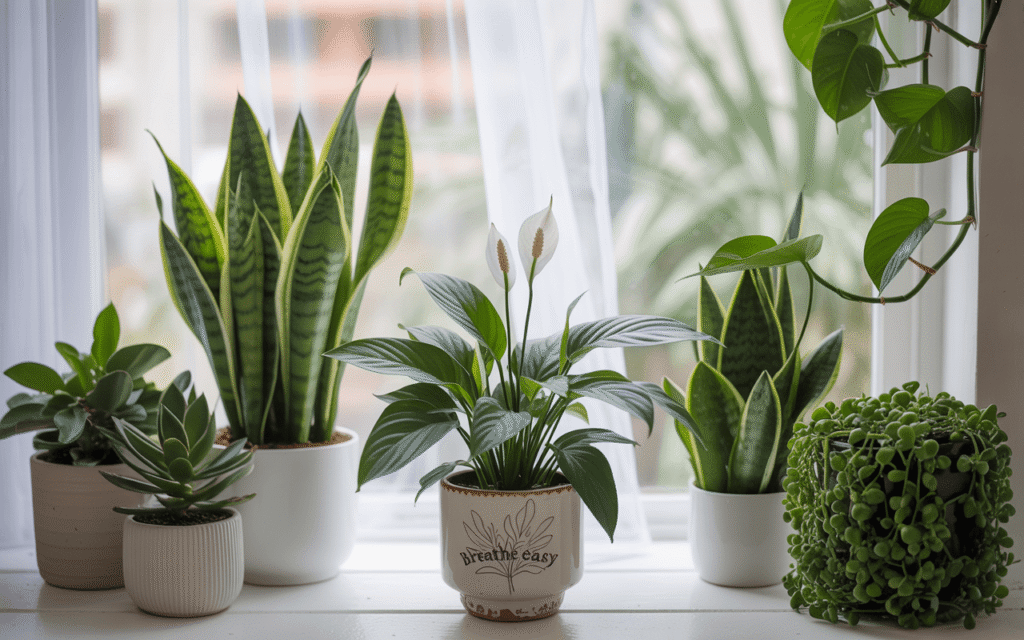Did you know the air inside your home can be up to five times more polluted than outdoor air? Shocking, right? Everyday items—like furniture, cleaning products, and even paint—release harmful toxins into our living spaces. Poor ventilation, dust, and chemicals can lead to allergies, headaches, or even long-term health problems.
The good news? Nature has already given us a solution: indoor plants for air purification. These green companions don’t just beautify your home; they also act as natural air filters, absorbing toxins, releasing fresh oxygen, and improving overall air quality.
Whether you live in a small apartment, a family home, or a workspace, adding the right indoor plants can transform your environment into a healthier, fresher sanctuary. In this guide, we’ll explore the best air-purifying indoor plants, their benefits, care tips, and how you can easily incorporate them into your lifestyle.
Why Air-Purifying Indoor Plants Matter
1. Combat Indoor Air Pollution
Indoor air often contains pollutants like benzene, formaldehyde, and trichloroethylene—chemicals found in plastics, paints, and household cleaners. Plants absorb these toxins through their leaves and roots, naturally cleaning the air.
2. Increase Oxygen Levels
Through photosynthesis, plants take in carbon dioxide and release fresh oxygen, making your living space healthier to breathe.
3. Reduce Stress and Boost Mood
Numerous studies show that being around greenery can reduce stress, improve concentration, and boost overall happiness.
4. Natural Humidifiers
Some plants release moisture into the air, helping to balance indoor humidity levels—especially beneficial during dry seasons or in air-conditioned rooms.
Best Indoor Plants for Air Purification
Here’s a list of the most effective air-cleaning plants, backed by research like NASA’s Clean Air Study:
1. Snake Plant (Sansevieria trifasciata)
- Why it’s effective: Known as Mother-in-law’s Tongue, this plant absorbs toxins like formaldehyde and benzene.
- Unique feature: Releases oxygen at night, making it perfect for bedrooms.
- Care tips: Thrives on neglect, tolerates low light, and requires minimal watering.
2. Peace Lily (Spathiphyllum)
- Why it’s effective: Removes ammonia, benzene, and trichloroethylene.
- Unique feature: Blooms with stunning white flowers that brighten any space.
- Care tips: Prefers medium light and consistently moist soil.
3. Spider Plant (Chlorophytum comosum)
- Why it’s effective: Great at removing carbon monoxide and xylene.
- Unique feature: Produces “baby spiderettes” that you can propagate easily.
- Care tips: Low-maintenance; grows well in indirect light.
4. Aloe Vera
- Why it’s effective: Filters formaldehyde and benzene.
- Unique feature: Gel inside leaves can be used for burns and skin care.
- Care tips: Needs bright light and infrequent watering.
5. Areca Palm (Dypsis lutescens)
- Why it’s effective: Adds humidity to the air while filtering toxins.
- Unique feature: Popular as a natural humidifier in dry climates.
- Care tips: Prefers bright, indirect light and regular watering.
6. Boston Fern (Nephrolepis exaltata)
- Why it’s effective: Removes formaldehyde and xylene.
- Unique feature: Adds lush greenery with its feathery fronds.
- Care tips: Loves humidity—perfect for bathrooms.
7. Rubber Plant (Ficus elastica)
- Why it’s effective: Strong toxin absorber, especially formaldehyde.
- Unique feature: Large glossy leaves add modern style to interiors.
- Care tips: Enjoys bright, indirect light and moderate watering.
8. Bamboo Palm (Chamaedorea seifrizii)
- Why it’s effective: Absorbs benzene and trichloroethylene.
- Unique feature: Adds a tropical feel while being a top air purifier.
- Care tips: Grows well in shaded areas with moist soil.
9. Chinese Evergreen (Aglaonema)
- Why it’s effective: Removes a variety of indoor toxins.
- Unique feature: Striking leaf patterns in green, silver, and red.
- Care tips: Tolerates low light and requires minimal care.
10. Pothos (Epipremnum aureum)
- Why it’s effective: One of the easiest plants to grow, removes benzene, toluene, and formaldehyde.
- Unique feature: Trailing vines make it perfect for hanging baskets.
- Care tips: Grows in low light and tolerates irregular watering.
How to Care for Air-Purifying Plants
Light Requirements
- Most thrive in bright, indirect light, though some like Snake Plants and Pothos tolerate low light.
- Avoid placing delicate plants in direct sunlight to prevent leaf burn.
Watering Routine
- Less is more: Overwatering is the number one killer of houseplants.
- Check soil moisture—water only when the top inch feels dry.
Humidity and Temperature
- Many air-purifying plants (like ferns and palms) love humidity.
- Use a humidifier, pebble tray, or mist leaves occasionally in dry environments.
Fertilizing
- Use a balanced liquid fertilizer during growing seasons (spring and summer).
- Reduce feeding in fall and winter when growth slows down.
Cleaning the Leaves
- Dust can block a plant’s ability to absorb toxins.
- Wipe leaves with a damp cloth every 2–3 weeks.
Best Locations for Air-Purifying Plants in Your Home
Bedroom
- Snake Plant, Aloe Vera, Peace Lily – Improve oxygen levels while you sleep.
Living Room
- Areca Palm, Rubber Plant, Fiddle Leaf Fig – Big statement plants that also clean the air.
Kitchen
- Spider Plant, Pothos, Aloe Vera – Combat cooking fumes and chemicals.
Bathroom
- Boston Fern, Bamboo Palm, Peace Lily – Love humidity and thrive in moist environments.
Office or Study
- Chinese Evergreen, Snake Plant, Rubber Plant – Reduce stress and boost productivity.
Benefits of Having Air-Purifying Indoor Plants
- Cleaner Air – Absorb toxins and release oxygen.
- Better Sleep – Some plants improve nighttime oxygen levels.
- Stress Relief – Greenery lowers anxiety and boosts mental clarity.
- Energy Boost – Fresher air means higher focus and productivity.
- Natural Décor – Adds beauty, elegance, and a calming vibe to interiors.
Step-by-Step Guide to Starting Your Indoor Air Purification Garden
- Identify your space – Decide where you want plants (bedroom, living room, office).
- Choose beginner-friendly plants – Start with low-maintenance options like Snake Plant, Spider Plant, or Pothos.
- Get the right pot and soil – Use well-draining soil and pots with drainage holes.
- Set a watering schedule – Keep track to avoid overwatering.
- Arrange for light – Position plants near windows but avoid harsh sunlight.
- Maintain and clean – Dust leaves, prune yellowing foliage, and fertilize when needed.
Common Problems and Solutions
- Yellowing leaves: Usually from overwatering. Let soil dry out.
- Brown tips: Caused by low humidity or chlorine in water. Try filtered water.
- Drooping plants: Could be due to lack of light or inconsistent watering.
- Pests: Use neem oil or insecticidal soap to treat spider mites or aphids.
FAQs About Air-Purifying Indoor Plants
1. Do indoor plants really purify the air?
Yes, studies like NASA’s Clean Air Study show that many plants can absorb toxins and improve air quality, though they work best alongside good ventilation.
2. Which air-purifying plant is best for bedrooms?
Snake Plant and Peace Lily are excellent for bedrooms as they release oxygen and thrive in low-light conditions.
3. How many plants do I need to clean the air in one room?
On average, 1–2 medium-sized plants per 100 square feet can noticeably improve air quality.
4. Are air-purifying plants safe for pets?
Not all are safe. For example, Peace Lily and Pothos are toxic to cats and dogs. Always check before choosing.
5. Can air-purifying plants replace air purifiers?
They complement but don’t completely replace air purifiers. Together, they create the best results.
Conclusion
Indoor plants for air purification are more than just beautiful décor—they’re natural health boosters. From the hardy Snake Plant to the lush Areca Palm, these plants clean the air, improve your well-being, and bring nature closer to your everyday life.
Whether you’re a beginner or a seasoned plant lover, adding a few air-purifying plants to your home is a simple step toward a healthier lifestyle.
🌱 Ready to start your journey? Discover more plant care tips and indoor gardening inspiration at Green Plant Zone—your go-to guide for creating a greener, fresher home.

Hi, I’m the creator of Green Plant Zone, a space dedicated to plant lovers. I share tips on indoor and outdoor gardening, plant care guides, and eco-friendly living. My mission is to help you grow healthier, happier plants and bring more greenery into everyday life.
